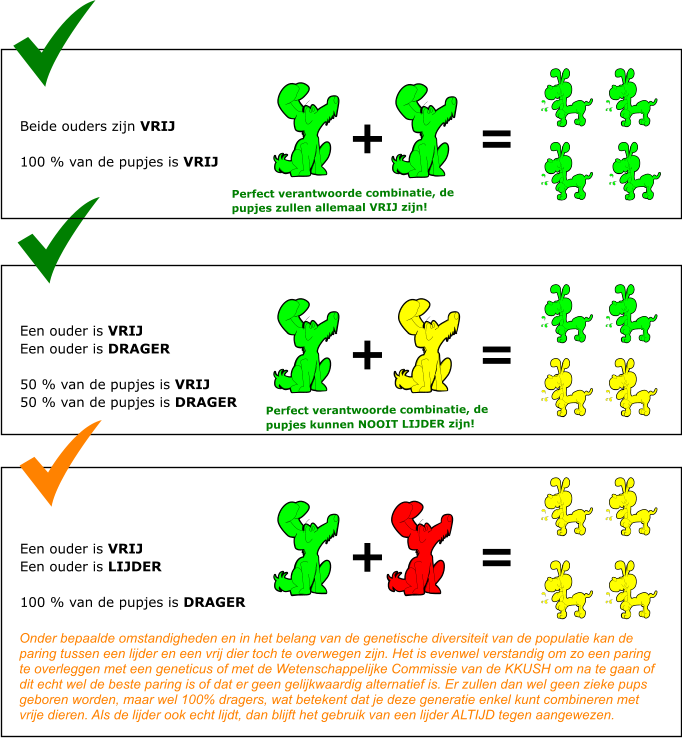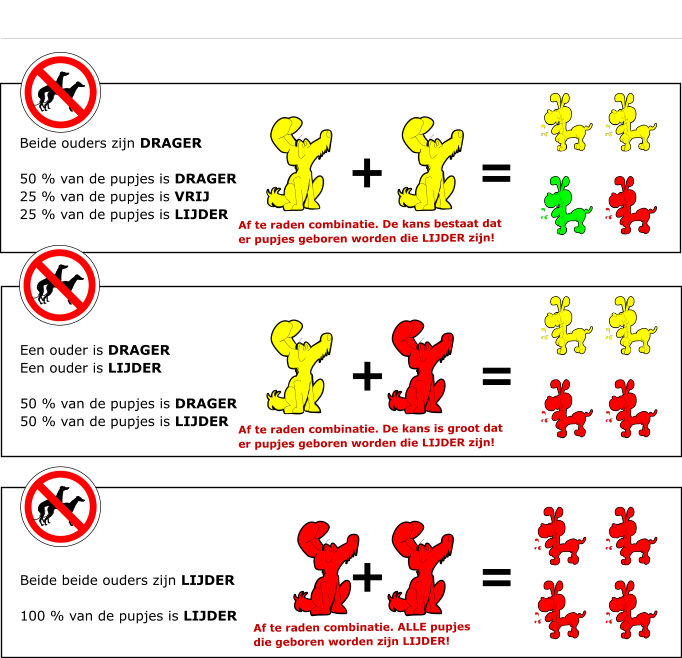PRA is an eye condition that causes blindness at a later age and is genetically transmitted to the next generations. It is difficult to avoid this disorder through breeding as this is a progressive hereditary disease.
Both parents can be carriers of the gene without having any symptons of the illness.
Background
The generalised progressive retical atrofy, GPRA or PRA is an eye disease that affects dogs. This continuous, progressive disease process leads to total blindness. It was described for the first time in 1911 on an Gordon Setter. PRA was diagnosed for the first time on an Irish Setter in 1938, whereas the same occured on a toy poodle in 1965. At the moment the illness is a problem for many breeders and dogs.
PRA is a degeneration of the retina. This tissue is located on the inside of the eye ball. It contains cells that determine eyesight: they are known as rods and cones.
These so-called photoreceptor cells absorb the light that is bundled by the eye lense and change this through chemical reaction in electric nerve signals. These signals are transmitted via the optic nerve to the brain, where they are converted into visible pictures. The rods are for seeing in twilight, the cones are for seeing in daylight as well as seeing colours. With PRA first the rods are affected which means the dog will see less in twilight. In a later phase also the cones are affected and this leads to total blindness.
PRA also affects humans the so-calles retinitis pigmentosa (RP)
There are different forms of PRA
PRA at an early age
Some breeds develop symptons at an early age, whereas with other breeds this disease only develops at a later age. For those breeds which develop the illness at an early age, the dog is already affected by night blindness at birth! Total blindness occurs here between second and fifth year of life.
Breeds where the illness occurs at an eary age are Irish Setter, Collie, the Norwegian Elkhound and the miniature Schnauzer. The illness in these dogs is caused by a reduced development of the rods an cones.
PRA at a later age
It can take up to four years before the first symptons occur with dogs that develop the disease at a later age. But generally speaking total blindnesss occurs at the age of five, in extreme cases before the age of eight. Dogs where the illness occurs at a later age are: toy poodle, the English and American Cocker Spaniel, Labrador retrievers and Tibetan Terriers.
With these breeds no symptons are visible at an early stage. The illness develops after the dog’s maturity.
The disease
For all breeds the illness develops in the same manner. Both eyes degenerate at the same time and the same level. At first the dog suffers from night blindness. This means they have difficulty in adapting their vision to situations in twilight. After some time the same problems arise during daylight. Some dogs become unsure in their movements, but most of them will adapt easily to their normal surroundings, while their vision deteriorates further. On condition however that their surroundings do not change.
Often the owner does not realise that his dog is slowly becoming blind. A widening of the pupil is visible, a kind of “glow” appears in the eyes which is caused by a stronger light reflection of the diseased retina. Some times you can also see a change in the eye lens, which becomes cloudy and opaque, resulting in cataract.
Examination of PRA3
A DNA test is availablle from anumber of labs to see whether a dog has this illness.
Our club use HTTPS://www.animaldnadiagnostics.co.uk. The test is done by the vet and sent to the lab.
The diagnosis
The PRA diagnosis can only be done through an eye examniation. Atropine drops are used to widen the pupils. We can see the following changes:
- An incresased reflection of the fundus ( that is the inside of the eyeball where the retina is)
- Decreased diameter and branching of the arteries in the retina.
- A reduced functioning and narrowing of the optic nerve ( linking the retina to the brain)
The early stages of the illness are specific to different breeds but when the dog has these changes, we can speak of already considerable loss of vision; and he will loose his vision within a short laps of time.
The club demands that their breeders have their breeding animals DNA tested, if both parents are free from you can skip one generation and the test is not necessary; the second generation however needs to be tested again.
| Following combinations are allowed |
- clear X clear
- carrier X clear
- carrier x carrier is not allowed !!
- Breeding with a affected dog is not allowed!!
|

|

|
| Thanks to this DNA test we can breed more conciously and avoid combinations that are not allowed. |
|


